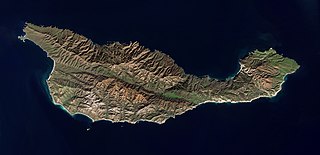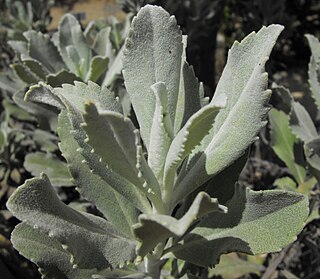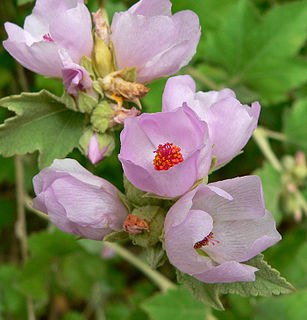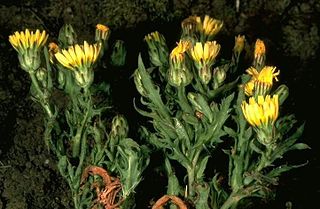
The Channel Islands are an eight-island archipelago located within the Southern California Bight in the Pacific Ocean, off the coast of California. The four Northern Channel Islands are part of the Transverse Ranges geologic province, and the four Southern Channel Islands are part of the Peninsular Ranges province. Five of the islands are within the Channel Islands National Park, and the waters surrounding these islands make up Channel Islands National Marine Sanctuary. The Nature Conservancy was instrumental in establishing the Channel Islands National Marine Sanctuary. The islands were inhabited as early as 13,000 years ago, the earliest paleontological evidence of humans in North America. They are the easternmost islands in the Pacific Island group.

Santa Cruz Island is located off the southwestern coast of Ventura, California, United States. It is the largest island in California and largest of the eight islands in the Channel Islands archipelago and Channel Islands National Park. Forming part of the northern group of the Channel Islands, Santa Cruz is 22 miles (35 km) long and 2 to 6 miles wide with an area of 61,764.6 acres (249.952 km2).

Lepechinia fragrans is a flowering herbaceous shrub known by the common names island pitchersage and fragrant pitchersage. It is a member of the Lamiaceae, or mint family, but like other Lepechinia, the flowers are borne in racemes instead of in mintlike whorls.

Arctostaphylos tomentosa is a species of manzanita known by the common name woollyleaf manzanita or woolley manzanita. This shrub is endemic to California.

Eriogonum arborescens is a species of wild buckwheat known by the common name Santa Cruz Island buckwheat.

Hazardia detonsa is a rare species of shrub in the family Asteraceae known by the common name island bristleweed. It is endemic to the Channel Islands of California, having been found on 4 islands.

Crocanthemum greenei is a rare species of flowering plant in the rock-rose family known by the common name island rush-rose. It is endemic to the Channel Islands of California, where it grows in the chaparral of the rocky seaside slopes. It is present on three of the eight islands, where it has historically been threatened by feral herbivores such as the Santa Cruz sheep and is making a gradual recovery. It is a federally listed threatened species.

Dendromecon harfordii, known by the common names Channel Islands tree poppy and Harford's tree poppy, is a species of flowering plant in the poppy family.

Arctostaphylos viridissima is a species of manzanita known by the common names whitehair manzanita and McMinn's manzanita. It is endemic to Santa Cruz Island, one of the Channel Islands of California.

Centaurium davyi is a species of flowering plant in the gentian family known by the common name Davy's centaury.
Chorizanthe wheeleri is a rare species of flowering plant in the buckwheat family known by the common names Santa Barbara spineflower and Wheeler's spineflower. It is endemic to Santa Cruz and Santa Rosa Islands, two of the Channel Islands of California.
Erigeron sanctarum is an uncommon species of flowering plant in the family Asteraceae known by the common names saints fleabane and saints daisy. It is endemic to California, where it is known from San Luis Obispo and Santa Barbara Counties including two of the Channel Islands.

Acmispon argophyllus, synonym Lotus argophyllus, is a species of legume native to California and northwest Mexico. It is known by the common name silver bird's-foot trefoil or silver lotus.

Malacothamnus fasciculatus, with the common name chaparral mallow, is a species of flowering plant in the mallow family. It is found in far western North America.

Malacothrix squalida is a rare species of flowering plant in the family Asteraceae known by the common name Santa Cruz desertdandelion. It is endemic to Santa Cruz and Anacapa Islands, two of the eight Channel Islands of California, where it grows on rocky seaside bluffs and cliffs. The plant is very limited in distribution and today exists only in degraded habitat on these two small islands. It was last collected from Santa Cruz Island in 1968, and two populations were noted on Anacapa Island in 1998; in drought years there may be no plants at all. It became a federally listed endangered species in 1997. This is an annual herb growing a hairless, waxy stem 20 to 30 centimeters in maximum height. The leaves are sharply lobed. The inflorescence is an array of flower heads lined with oval-shaped phyllaries. The ray florets are 1 to 2 centimeters and light yellow in color.

Ribes thacherianum, with the common name Santa Cruz gooseberry, or Santa Cruz Island gooseberry, is a rare North American species of currant found only on one island off the coast of California.
Sanicula hoffmannii is an uncommon species of flowering plant in the family Apiaceae known by the common names Hoffmann's blacksnakeroot and Hoffmann's sanicle. It is endemic to California, where it is known from the Channel Islands and a few locations in the coastal mountain ranges of the mainland, including the Scott Creek watershed in Santa Cruz County. Its habitat includes coastal hillsides and mountain slopes, sometimes with serpentine soils. It is a perennial herb producing a thick stem up to 90 centimeters tall from a taproot. The green or bluish leaves are compound, the blades each divided into about three lobed, toothed leaflets. The inflorescence is made up of one or more heads of bisexual and male-only flowers with tiny, curving, yellow-green petals.

Sibara filifolia, the Santa Cruz Island winged rockcress or Santa Cruz Island rockcress, is a rare species of flowering plant in the family Brassicaceae. It is endemic to the Channel Islands of California, where it is now known from a few occurrences on San Clemente Island and one population on Catalina Island.

Thysanocarpus conchuliferus is a rare species of flowering plant in the mustard family known by the common name Santa Cruz Island fringepod. It is endemic to Santa Cruz Island, one of the Channel Islands of California, where has been recently observed at only one location; some years it is totally absent.

Quercus pacifica is a species of oak known by the common names island scrub oak, Channel Island scrub oak, and Pacific oak.

















